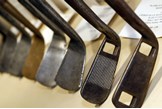When to upgrade your golf clubs: The signs that give you license to re-build your bag
Published: Last updated:
Dreaming of shiny new metal but unsure if the time is right? Today’s Golfer helps you decide whether to stick or twist.
For most golfers dwelling on this question, it’s unlikely that your decision will be catastrophically wrong.
Perhaps you could have extracted another year’s use from the best driver you’ve ever had, or perhaps it should have been retired in a blaze of glory at last year’s Boxing Day scramble.
Either way, your instinct that they’re towards the end of their playing days will be correct, and your only real danger is going bust by stubbornly refusing to part way with metal that’s past its ‘use-by’ date.
Are your clubs past their ‘best-before’ date, however? That’s the question with a more nuanced answer that can help reign in your impulsiveness or give you the kick of confidence needed to partway with your cash.
Here’s our guide to help you make the most informed decision about when to upgrade your golf clubs.

How long should each club last?
Unsurprisingly, regardless of which club you are thinking about replacing, the answer will always be caveated with ‘depending on how much you play’. While a pro will go through multiple sets of irons a year, a club golfer playing once a fortnight might get five years plus from a new set.
Depreciation through wear and tear is to be expected with all clubs, but as you will see, not all clubs age with the same level of dignity.
Driver
Due to their frequent use and the intensity of each strike, drivers typically have the shortest shelf life and will likely start to experience a drop-off in performance after approximately 150 rounds. This still gives a driver a good three years of game time for a golfer playing once a week.

Fairways & Hybrids
Similar to your driver due to taking a fair battering out on the course, we place an estimate of around 200 rounds on the best fairway woods and hybrids. Three to five years is a good time frame to consider upgrading depending on how often you reach for these longer clubs throughout a typical round.
Irons
We agree with the research that tends to suggest a set of quality irons will do you well for a good 300 rounds before you need to consider upgrading them. Whilst technology moves on quickly, a once-weekly golfer replacing their irons every five years is unlikely to experience any reduced performance.

Wedges
As TG’s short-game expert Will Shreeve-Peacock says in our guide to choosing the best golf wedge, we would recommend golfers look to replace their wedges every 60 to 100 rounds, which for most golfers will give them a two-year life cycle. Ideally, you would test them against a new wedge to see how your spin rate and launch angle have been affected over time.
Putters
As balls on the green don’t experience the same level of ferocity as from other clubs in the bag, it’s not uncommon for players to keep the same putter in their bags for well over ten years. A red-hot putter is worth its weight in gold and you should hold on to it at all costs.

What are the signs you should look out for?
Severity of wear and tear
The most obvious tell-tale sign that you are overdue an upgrade is any obvious physical damage. This can take the form of chips to any part of the clubhead, a splintering of the shaft, or grooves that have lost their sharpness for example.
All of the above can significantly affect aerodynamic qualities and the club’s interaction with the ball at impact, causing sub-optimal ball flight and spin characteristics. Damage to your grip is less concerning as you can easily have the club re-gripped, which in itself can boost performance.

Distance gaps
Do you regularly find yourself in situations where you never seem to have the right club for the situation? If so, it could be a sign that you should upgrade to backfill distance gaps in your setup.
Whether you have a full 14-club quota or a couple of free slots, consider which end of your bag is getting the easy ride and which end leaves you with very few shot choices. If you carry three or four wedges, is it worth replacing one with a utility club that bridges the gap between your 19° 5-wood 27° 5-iron for example? Perhaps one of the best 7-woods could be a good option. These are the types of questions worth asking yourself.

Off-the-tee performance
Nothing should get you scrolling through our best driver pages quicker than seeing a regular pattern of your balls not traveling as far as you expect or ballooning upwards from the tee with more backspin than you’re used to. And, if your playing partner starts out driving you from nowhere…well, that is a cause for concern!
Keep an eye out for indications of irregular ball flights, particularly after a few years as this is as good a sign as any to upgrade your big stick.
Dull grooves
A point worth reiterating is that to get the best out of your wedges and your strongest lofted irons, having sharp grooves is key. Control into and around the greens depends on how effectively your ball grabs into the grooves and can have a huge impact on your scorecard.
Whilst there is some evidence that groove-sharpening tools can help prolong the life of your wedges, a new club is the way forward if you feel it’s getting toward that time. Regardless of standard, wedges typically have the steepest drop-off in performance and will need replacing most often.

Technology
Exponential developments in fields such as materials science, artificial intelligence, and engineering mean that golf club technology is constantly evolving to offer new benefits. Some of the latest launches include AI-inspired designs with never-before-seen levels of forgiveness
Luckily, performance gains are fairly incremental, and you shouldn’t feel too aggrieved if your recent purchase has just been superseded by the latest game-changing technology. It’s not until you get towards the five-year mark that the current tech inside your clubhead may be holding your game back compared to some newer models. That said, it’s not uncommon to see tour pros gaming models that are several years old. If it works, it works!
Lack of adjustability
Most of the drivers, fairway woods, and hybrids on offer today from powerhouse brands feature adjustable hosels, allowing you to tweak the loft and lie of the clubhead. Many also feature interchangeable weight ports or sliding weight mechanisms so you can promote a certain shot shape, or launch angle, or correct a slice for example.
If your current equipment doesn’t have this capability, then it’s a potential reason to upgrade as adjustability can pay dividends for golfers of all abilities.

Course type
Perhaps not the most pressing reason to upgrade, but considering how appropriate your setup is for the type of course and conditions you play may be a worthwhile exercise.
For example, do your wedges have the optimal amount of bounce for the ground conditions of your home course? And if you play regularly on wind-swept links courses, do you carry a driving iron to give you an alternative option to driver when it’s blowing a hooley?
You want new clubs
Of course, if you have the budget and love to keep your bag updated with the latest equipment, then why not shop away? Just keep in mind that if your clubs are still in good playable condition, part-exchanging them with companies such as Golfbidder presents an excellent opportunity for your clubs to continue their career with a new golfer and secure some cash for your next upgrade at the same time.

Can you make your clubs last longer?
A final consideration goes to how you can best take care of your clubs to help reduce wear and tear and keep them in prime condition. We recommend:
– Not storing clubs away wet to preserve rusting.
– Always use head covers on your woods and putter to prevent damage.
– Cleaning your clubface between shots to prevent the buildup of dirt and sand that can wear away groove sharpness over time.
– Regularly inspecting shafts and clubheads to ensure you not playing with damaged clubs that will impact performance.
– Asking your club pro to check the loft and lie of your clubs as they are liable to change over time.
SUBSCRIBE TO TODAY’S GOLFER: Print and Digital access, discounts and rewards!
About the author

Ross Tugwood
Golf Equipment Writer
Ross Tugwood is a golf equipment writer for todays-golfer.com, specializing in data, analytics, science, and innovation.
Ross is passionate about optimizing sports performance and has a decade of experience working with professional athletes and coaches for British Athletics, the UK Sports Institute, and Team GB.
He has post-graduate degrees in Performance Analysis and Sports Journalism, enabling him to critically analyze and review the latest golf equipment and technology to help you make better-informed buying decisions.


